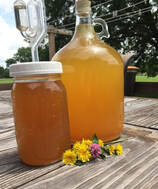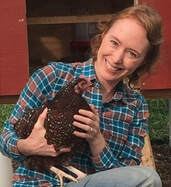
Always an adventure, this fermentation foray has been especially eventful - including explosions, spewing jugs, yeasty lessons, and more. Read on to find out how to make your own dandelion wine - as well as what NOT to do, as I learned the hard way! :-)
Homemade Dandelion Wine Recipe
Yield: 1 Gallon(ish)
Active Time: 1-2 hours, depending on available helpers!
Fermentation Time: 5-6 months (or more)
Ingredients:
- 3 quarts non-chlorinated water (approximate, more to fill)
- 3 pounds sugar (roughly 5 to 6 cups) (I used mostly white sugar, but added some raw Turbinado sugar during the second ferment, which is why it looks so dark in the picture.)
- 1-quart dandelion petals, picked from roughly 3-4 quarts blossoms
- 3 oranges – juice and zest
- 1 lemon – juice and zest
- 1 tsp yeast nutrient (alternatively, you can add a small handful of raisins (about 2 TBs), but it will slightly alter the flavor of your wine. You can also ferment without either of these, but it will take longer.)
- 1 packet wine yeast* or champagne yeast**
** Note: Champagne yeast makes a drier wine and may take longer to finish fermenting as it will eat up more of the sugar; if using champagne yeast, you may want to reduce the amount used if you prefer a sweeter wine. (More on this below.)
Instructions:
- Bring the water and sugar to a boil in a saucepan. Stir to dissolve the sugar and cool to lukewarm.
- Place the dandelion petals, citrus juice and zest into a one-gallon fermentation vessel (wide mouth highly recommended). Add the yeast nutrient and pour the lukewarm sugar water over the top.
- Dissolve a packet (or appropriate portion of a packet) of champagne yeast or other wine yeast in lukewarm water. Allow it to stand for 5 minutes to rehydrate and then pour it into the wine vessel. Top off with a bit of extra water to fill the vessel, but be sure to leave at least an inch of headspace.
- Cap with an airlock and ferment for about 3 weeks or until fermentation has stopped. It will take a bit longer if you don’t use raisins or yeast nutrient because they provide extra micro-nutrients to get the yeast working faster.
- Siphon the wine into a clean container, leaving the yeast sediment behind. Reapply the lid and air lock and allow the wine to ferment in secondary for at least 6 to 8 weeks, checking the water lock periodically to ensure that the water hasn’t evaporated.
- Siphon the dandelion wine into a clean container, again leaving the sediment behind, to prepare for bottling.
- Bottle the dandelion wine in corked wine bottles for longer storage, or flip top Grolsch-style bottles for smaller batches you’re not planning on storing long.
- Allow the wine age in the bottle at least 2 months before drinking, ideally 6 months or more. (During aging, the wine should be kept somewhere cool-ish like a basement or closet on the north side of the house.)
The Journey Begins...
I started off just fine, having collected an abundance of dandelions over a couple of days (I pulled the petals off the first batch the first day and stored them in the freezer until day 2) during which I picked enough to collect a quart of petals in total. Tip: I found that pulling the petals off, though it was slower than cutting with scissors, was better at avoiding green pieces, and you could get more of the petals out that way.
In hindsight, I made a couple of mistakes up front, though. One was that my "1 gallon" fermentation bucket (which I had never used before) turned out to be substantially larger than 1 gallon, which necessitated having to heat and de-chlorinate more water halfway through the process when I felt like the bucket wasn't full enough. This meant that my sugar/water ratio was off from the start, though I did add a bit more sugar to compensate. (I also felt like the amount of sugar was excessive, so I may have skimped on it a bit anyway.)
However, I'm not sure how much that mattered. The more important issue was that I used too much yeast - which was Mistake #1.
I have a stack of champagne yeast packets in the freezer that my husband bought me several years ago. I have made numerous batches of cider and other beverages with it, and have still not finished even one packet of yeast! It is incredibly strong, and ferments everything it touches into complete bubbly dryness, no matter how hard I try to keep this from happening.
Knowing the strength of this particular yeast, I did my best to use the smallest amount possible, but also kept in mind that I had added almost an entire bag of sugar, so was hoping that would offset it. I think I ended up adding something like a scant 1/4 teaspoon of yeast to the whole bucket - maybe even a bit less.
I wasn't planning to use yeast nutrient, but discovered I had a bottle of it in a fermentation kit someone gave me a few years back, so I did use it as instructed.
Then I set the bucket to ferment - which it did - VIGOROUSLY - for a week or so. The air lock was bubbling non-stop every 5 seconds for a few days, and you could hear the hissing of the bubbles inside the bucket from a foot away! Eventually it slowed, and when it seemed to stop, I strained out the petals and siphoned the golden liquid into my second fermentation vessel - a 1-gallon glass carboy.
This was when I discovered how much extra was in my bucket! I ended up with about 2 quarts more than the carboy would hold. I figured this wasn't a bad thing - we would have some extra to sample throughout the process.
However, when I tasted it, it was absolutely terrible! It tasted like yeasty, dry, alcoholic water - bland, and while not bitter, simply very unpalatable. Not a single speck of the pounds of sugar I had added remained. It tasted NOTHING like the delicious, sweet, floral elixir I had sampled from a neighbor who makes his own dandelion wine.
I was disappointed, but not entirely hopeless, as the hard cider that I make every year is usually not exactly drinkable after the first fermentation - or sometimes even the second. From my experience, fermented beverages typically improve quite a bit after some aging, so I am hopeful the wine come out okay in the long run - especially after tasting it again recently (which I will get to in a minute).
Anyway, I poured the extra into a couple of jars, but since I only had one free airlock, and the third bottle wasn't quite a full quart, I figured I would just put it in a smaller jar with a screw-on lid and "burp" or loosen the lid daily... (Did you guess this was Mistake #2?)
I then added some more sugar to each vessel to try to sweeten it up a bit and get the yeast to finish and settle out.
The fermentation continued, though much less aggressively than the first time around, and I faithfully loosened the lid of the regular jar daily - though not always twice a day. It bubbled and sparkled quite prettily every time I opened it, and I tasted it a few times and it seemed to be improving.
One night, my husband jumped out of bed around 2:00am and turned on the light, startling me awake as he hurried out of the room. Alarmed, I waited a minute or two, then followed him. "What's going on?" I asked sleepily? "A bottle exploded," he replied, "and there's glass all over the kitchen. It smells like a brewery out there!"
So much for my extra bottle of dandelion wine!
I put on my slippers and mopped up the spilled wine and shards of glass, then headed back to bed. Lesson learned: ALWAYS use an airlock. :-)
This weekend, I checked the calendar and according to the recipe above, we have about a month to go until bottling, so I figured it would probably be a good idea to taste it and add more sugar if it needed it. I poured a little out of the glass carboy into a glass, where it was just slightly sparkling, and had a light, fresh, effervescent flavor - quite a big improvement from the first time around. However, it was still fairly dry. I figured I would just pour a little sugar in - not a lot, but enough to replace the small glass I had poured out, which was probably about half a cup or less.
Mistake #3: I grabbed my handy little funnel, and dumped in about 1/4 cup of sugar to start. Whooom! It was as if the jug suddenly came to a full boil! Wine gushed up out of the mouth of the carboy and all over the counter in a seemingly unending fountain of bubbles! I grabbed the jug and carried it to the sink, leaving a foaming trail behind me, and losing a good cup or more of liquid.
After I cleaned up the mess, I set about trying to rectify the situation. Between the extra quart jar I still had, and adding more sugar SLOWLY and a bit at a time, I was able to fill both jars back up and reapply the air locks. The good thing is, the wine was already a bit less dry already this time, and with adding the extra sugar to top it all off, I'm hoping it will retain some sweetness as it finishes. We will see...
I will keep you posted as the adventure continues! In the meantime, feel free to check out some of my other posts on fermented foods and beverages (the ginger ale is particularly delicious and great for summer).
Rose.
Recipe Source: PracticalSelfReliance.com



 RSS Feed
RSS Feed